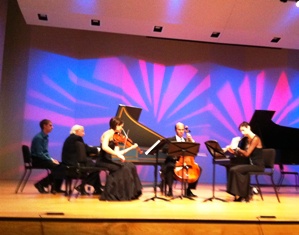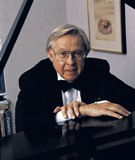
Charles Wadsworth a Treat for Constella
“I will remember this concert for the rest of my life,” said
violinist Tatiana Berman, following the Constella Festival's "An Evening with Charles Wadsworth" Oct. 6 at Northern Kentucky University.

Doubtless, so will everyone else who attended the concert, held in Greaves Concert Hall.
Pianist and chamber music guru Wadsworth (founder of the Chamber Music Society of Lincoln Center) not only lent his extraordinary artistry to the program, he thoroughly charmed the audience as a raconteur. Speaking from the stage, he introduced and commented on the music, his delight in coming to Cincinnati, himself (disparagingly) and just about anything else that came to mind, including the evening’s Cincinnati Reds game. He was equally engaging meeting people after the concert.
The event was presented by NKU as a partner organization
for the 2012 Constella Festival of Music and Fine Arts. Bringing Wadsworth to Cincinnati was a coup engineered by Nina Perlove, instructor in
flute at NKU. Perlove, who performed with Wadsworth along with Berman and
cellist Nathaniel Chaitkin, is also executive director of the Cincinnati-based
American Classical Music Hall of Fame. As such, she traveled to the Spoleto USA Festival in Charleston, South
Carolina last spring to induct Wadsworth into the Hall of Fame (Wadsworth heads chamber music activities at Spoleto USA, as well).
The invitation to Cincinnati followed.

Beyond charming the audience, Wadsworth was above all an inspiration to his fellow
performers (as all agreed in addition to Berman).
The concert opened with Haydn’s Trio for Piano, Flute and Cello in G Major (Hob.XV:15), a work, Wadsworth noted, filled with the composer’s famous wit. The Allegro took off with numerous perky appoggiaturas (a dissonant pitch struck on a strong beat and immediately resolving step-wise). The Andante that followed was given welcome nuance by the performers, while the Finale, a merry rondo was made even merrier by repeated pauses and a deceptive cadence near the end. Perlove joined Wadsworth in his own “Song Without Words,” a lovely piece which would be quite at home at the movies. There is a love story behind it, he said, and it came through in the music’s romantic sheen and the outpouring of piano as Wadsworth moved into the main theme.
The first of three sonatas by French composers came next, beginning with Poulenc’s Sonata for Flute and Piano. Perlove and Wadsworth made exceptional collaborators in this favorite work, giving it a ravishing performance, always at one with the music. Berman and Chaitkin followed in the first two movements of Ravel’s Sonata for Violin and Cello, a work not heard as often as it should be. It was a feast for the ears and filled the hall with gesture and color. The second movement, "Très vif," was particularly rewarding, with its Hungarian flavor and virtuosic effects.
The Trio in C Minor for Flute, Violin, Cello and Harpsichord by German baroque composer Johann Joachim Quantz made a fine contrast with the predominantly Gallic repertoire on the rest of the program. Berman led the ensemble with baroque-informed taste and expression. The Allegro (second movement) had a spring in its step, Chaitkin provided a warm-colored “walking bass” in the Larghetto, and the closing Vivace sparkled. Wadsworth, who appeared to be enjoying himself enormously, performed on the French double manual harpsichord crafted by Northern Kentucky harpsichord maker James Campbell in 1984.
As Berman correctly felt, there was true energy in Debussy's Sonata for Violin and Piano, which she performed with Wadsworth. It was an extraordinary performance by both artists. Mutual tone production and inflection were perfectly crafted and every detail was exquisitely in place. Berman projected with ease and beauty on the violin’s lowest string, delivered suave pizzicato in the second movement, and was all over the fiddle in the Finale.
Perlove and Wadsworth brought the concert to a memorable end with French composer Cécile Chaminade’s Concertino for Flute, Op. 107 (1902). Chaminade’s most popular work today (and never out of the repertoire), it was a perfect vehicle for the prodigious Perlove (also known as “the internet flutist,” see www.REALFLUTEproject.com). From the elegant, assertive opening, through passages of jollity and downright virtuosity, it was a brilliant conclusion to a thoroughly enjoyable concert that drew plaudits from the crowd.